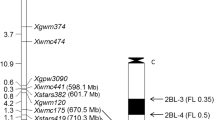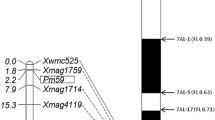Abstract
Key message
A new recessive powdery mildew resistance gene, Pm223899, was identified in Afghanistan wheat landrace PI 223899 and mapped to an interval of about 831 Kb in the terminal region of the short arm of chromosome 1A.
Abstract
Wheat powdery mildew, a globally important disease caused by the biotrophic fungus Blumeria graminis f.sp. tritici (Bgt), has occurred with increased frequency and severity in recent years, and some widely deployed resistance genes have lost effectiveness. PI 223899 is an Afghanistan landrace exhibiting high resistance to Bgt isolates collected from the Great Plains. An F2 population and F2:3 lines derived from a cross between PI 223899 and OK1059060-126135-3 were evaluated for response to Bgt isolate OKS(14)-B-3-1, and the bulked segregant analysis (BSA) approach was used to map the powdery mildew resistance gene. Genetic analysis indicated that a recessive gene, designated Pm223899, conferred powdery mildew resistance in PI 223899. Linkage analysis placed Pm223899 to an interval of about 831 Kb in the terminal region of chromosome 1AS, spanning 4,504,697–5,336,062 bp of the Chinese Spring reference sequence. Eight genes were predicted in this genomic region, including TraesCS1AG008300 encoding a putative disease resistance protein RGA4. Pm223899 was flanked proximally by a SSR marker STARS333 (1.4 cM) and distally by the Pm3 locus (0.3 cM). One F2 recombinant was identified between Pm3 and Pm223899 using a Pm3b-specific marker, indicating that Pm223899 is most likely a new gene, rather than an allele of the Pm3 locus. Pm223389 confers a high level of resistance to Bgt isolates collected from Pennsylvania, Oklahoma, Nebraska, and Montana. Therefore, Pm223389 can be used to enhance powdery mildew resistance in these states. Pm3b-1 and STARS333 have the potential to tag Pm223389 in wheat breeding.


Similar content being viewed by others
Change history
01 November 2018
Unfortunately, the caption of Fig. 2 was incorrectly published in the original publication. The complete correct caption should read as follows.
References
Bennett FGA (1984) Resistance to powdery mildew in wheat: a review of its use in agriculture and breeding programs. Plant Pathol 33:279–300
Bhullar NK, Street K, Mackay M, Yahiaoui N, Keller B (2009) Unlocking wheat genetic resources for the molecular iden-tification of previously undescribed functional alleles at the Pm3 resistance locus. Proc Natl Acad Sci USA 106:9519–9524
Bhullar NK, Mackay M, Keller B (2010) Genetic diversity of the Pm3 powdery mildew resistance alleles in wheat gene bank accessions as assessed by molecular markers. Diversity 2:768–786
Cesari S, Thilliez G, Ribot C, Chalvon V, Michel C, Jauneau A, Rivas S, Alaux L, Kanzaki H, Okuyama Y, Morel JB (2013) The rice resistance protein pair RGA4/RGA5 recognizes the Magnaporthe oryzae effectors AVR-Pia and AVR1-CO39 by direct binding. Plant Cell 25:1463–1481
Cowger C, Parks R, Marshall D (2009) Appearance of powdery mildew of wheat caused by Blumeria graminis f. sp. tritici on Pm17-bearing cultivars in North Carolina. Plant Dis 93:1219
Cowger C, Mehra L, Arellano C, Meyers E, Murphy JP (2018) Virulence differences in Blumeria graminis f. sp. tritici from the central and eastern United States. Phytopathology 108:402–411
Dubcovsky J, Galvez AF, Dvořák J (1994) Comparison of the genetic organization of the early salt-stress-response gene system in salt tolerant Lophopyrum elongatum and salt-sensitive wheat. Theor Appl Genet 87:957–964
Fu B, Chen Y, Li N, Ma H, Kong Z, Zhang L, Jia H, Ma Z (2013) pmX: a recessive powdery mildew resistance gene at the Pm4 locus identified in wheat landrace Xiaohongpi. Theor Appl Genet 126:913–921
Fu BS, Zhang ZL, Zhang QF, Wu XY, Wu JZ, Cai SB (2017) Identification and mapping of a new powdery mildew resistance allele in the Chinese wheat landrace Hongyoumai. Mol Breed 37:133
Griffey CA, Rohrer WL, Pridgen TH, Brooks WS, Chen J, Wilson JA, Nabati D, Brann DE, Rucker EG, Behl HD, Vaughn ME (2005a) Registration of’ McCormick wheat. Crop Sci 45:417–420
Griffey CA, Rohrer WL, Pridgen TH, Brooks WS, Chen J, Wilson JA, Nabati D, Brann DE, Rucker EG, Behl HD, Vaughn ME (2005b) Registration of Tribute wheat. Crop Sci 45:419–421
Hsam SLK, Huang XQ, Zeller FJ (2001) Chromosomal location of genes for resistance to powdery mildew in common wheat (Triticum aestivum L. em Thell.) 6. Alleles at the Pm5 locus. Theor Appl Genet 102:127–133
Hu TZ, Li HJ, Xie CJ, You MS, Yang ZM, Sun QX, Liu ZY (2008) Molecular mapping and chromosomal location of powdery mildew resistance gene in wheat cultivar Tangmai 4. Acta Agron Sin 34:1193–1198
Huang XQ, Hsam SLK, Zeller FJ et al (2000a) Molecular mapping of the wheat powdery mildew resistance gene Pm24 and marker validation for molecular breeding. Theor Appl Genet 101:407–414
Huang XQ, Hsam SLK, Zeller FJ (2000b) Chromosomal location of powdery mildew resistance genes in Chinese wheat (Triticum aestivum L. em. Thell.) landraces Xiaobaidong and Fuzhuang 30. J Genet Breed 54:311–317
Huang X, Wang L, Xu M, Röder M (2003) Microsatellite mapping of the powdery mildew resistance gene Pm5e in common wheat (Triticum aestivum L.). Theor Appl Genet 106:858–865
Hurni S, Brunner S, Buchmann G, Herren G, Jordan T, Krukowski P, Wicker T, Yahiaoui N, Mago R, Keller B (2013) Rye Pm8 and wheat Pm3 are orthologous genes and show evolutionary conservation of resistance function against powdery mildew. Plant J 76:957–969
Kosambi DD (1943) The estimation of map distances from recombination values. Ann Eugen 12:172–175
Li G, Xu X, Bai G, Carver BF, Hunger R, Bonman JM (2016) Identification of novel powdery mildew resistance sources in wheat. Crop Sci 56:1817–1830
Lillemo M, Asalf B, Singh RP, Huerta-Espino J, Chen XM, He ZH, Bjørnstad Å (2008) The adult plant rust resistance loci Lr34/Yr18 and Lr46/Yr29 are important determinants of partial resistance to powdery mildew in bread wheat line Saar. TheorAppl Genet 116:1155–1166
Lincoln SE, Daly MJ, Lander ES (1993) Constructing genetic linkage maps with MAPMAKER/EXP Version 3.0: a tutorial and reference manual. A Whitehead Institute for Biomedical Research Technical Report, 3
Liu RH, Meng JL (2003) MapDraw: a Microsoft excel macro for drawing genetic linkage maps based on given genetic linkage data. Hereditas 25:317–321
Ma HQ, Kong ZX, Fu BS, Li N, Zhang LX, Jia HY, Ma ZQ (2011) Identification and mapping of a new powdery mildew resistance gene on chromosome 6D of common wheat. Theor Appl Genet 123:1099–1106
McIntosh RA, Yamazaki Y, Dubcovsky J et al (2013) Catalogue of gene symbols for wheat. In: Ogihara Y (ed) Proccedings of the 12th international wheat genet symposium, Yokohama, Japan 8–13 Sept 2013, pp 8–13
McIntosh RA, Dubcovsky J, Rogers WJ et al (2017) Catalogue of gene symbols for wheat. Supplement. Annu Wheat Newsl 53:1–20
Mohler V, Hsam SL, Zeller FJ, Wenzel G (2001) An STS marker distinguishing the rye-derived powdery mildew resistance alleles at the Pm8/Pm17 locus of common wheat. Plant Breed 120:448–450
Morgounov A, Tufan HA, Sharma R et al (2012) Global incidence of wheat rusts and powdery mildew during 1969–2010 and durability of resistance of winter wheat variety Bezostaya 1. Eur J Plant Pathol Dordr 132:323–340
Sánchez-Martín J, Steuernagel B, Ghosh S et al (2016) Rapid gene isolation in barley and wheat by mutant chromosome sequencing. Genome Biol 17(1):221
Shimizu Y, Nasuda S, Endo TR (1997) Detection of the Sec-1 locus of rye by a PCR-based method. Genes Genet Syst 72:197–203
Sun H, Hu J, Song W (2018) Pm61: a recessive gene for resistance to powdery mildew in wheat landrace Xuxusanyuehuang identified by comparative genomics analysis. Theor Appl Genet. https://doi.org/10.1007/s00122-018-3135-1
Tan C, Li G, Cowger C, Carver BF, Xu X (2018) Characterization of Pm59, a novel powdery mildew resistance gene in Afghanistan wheat landrace PI 181356. Theor Appl Genet 131:1145–1152
Wang X, Wang L (2016) GMATA: an integrated software package for genome-scale SSR mining, marker development and viewing. Front Plant Sci 7:1350
Wang Z, Li H, Zhang D, Guo L, Chen J, Chen Y, Wu Q, Xie J, Zhang Y, Sun Q, Dvorak J (2015) Genetic and physical mapping of powdery mildew resistance gene MlHLT in Chinese wheat landrace Hulutou. Theor Appl Genet 128:365–373
Xiao M, Song F, Jiao J et al (2013) Identification of the gene Pm47 on chromosome 7BS conferring resistance to powdery mildew in the Chinese wheat landrace Hongyanglazi. Theor Appl Genet 126:1397–1403
Xing L, Hu P, Liu J, Cui C, Wang H, Di Z, Zhou S, Xu J, Gao L, Huang Z, Cao A (2017) NLR1-V, a CC-NBS-LRR encoding gene, is a potential candidate gene of the wheat powdery mildew resistance gene Pm21. bioRxiv 114058
Xu XY, Bai GH, Carver BF, Shaner GE, Hunger RM (2006) Molecular characterization of a powdery mildew resistance gene in wheat cultivar Suwon 92. Phytopathology 96:496–500
Xu H, Yi Y, Ma P, Qie Y, Fu X, Xu Y, Zhang X, An D (2015) Molecular tagging of a new broad-spectrum powdery mildew resistance allele Pm2c in Chinese wheat landrace Niaomai. Theor Appl Genet 128:2077–2084
Xu XD, Feng J, Fan JR, Liu ZY, Li Q, Zhou YL, Ma ZH (2018a) Identification of the resistance gene to powdery mildew in Chinese wheat landrace Baiyouyantiao. J Integr Agric 17:37–45
Xu XD, Li Q, Ma ZH, Fan JR, Zhou YL (2018b) Molecular mapping of powdery mildew resistance gene PmSGD in Chinese wheat landrace Shangeda using RNA-seq with bulk segregant analysis. Mol Breed 38:23
Xue F, Wang C, Li C et al (2012) Molecular mapping of a powdery mildew resistance gene in common wheat landrace Baihulu and its allelism with Pm24. Theor Appl Genet 125:1425–1432
Yahiaoui N, Srichumpa P, Dudler R, Keller B (2004) Genome analysis at different ploidy levels allows cloning of the powdery mildew resistance gene Pm3b from hexaploid wheat. Plant J 37:528–538
Yahiaoui N, Kaur N, Keller B (2009) Independent evolution of functional Pm3 resistance genes in wild tetraploid wheat and domesticated bread wheat. Plant J 57:846–856
Zhai WW, Duan XY, Zhou YL, Ma HQ (2008) Inheritance of resistance to powdery mildew in four Chinese landraces. Plant Prot 34:37–40
Zou S, Wang H, Li Y, Kong Z, Tang D (2018) The NB-LRR gene Pm60 confers powdery mildew resistance in wheat. New Phytol 218:298–309
Acknowledgements
We thank M. Hargrove and R. Whetten for excellent technical assistance and Dr. Robert McIntosh of Sydney University for reviewing this paper. Mention of trade names or commercial products in this publication is solely for the purpose of providing specific information and does not imply recommendation or endorsement by the USDA. The USDA is an equal opportunity provider and employer.
Author information
Authors and Affiliations
Corresponding author
Ethics declarations
Conflict of interest
The authors declare that they have no conflicts of interest.
Additional information
Communicated by Xianchun Xia.
Unfortunately, the caption of Figure 2 was incorrectly published in the original publication. The complete correct caption should read as follows.
Fig. 2 Graphical genotypes and phenotypes of critical F2 plants and corresponding F3 phenotypes. Pm223899 was mapped to an interval flanked by Pm3b-1 and STARS333. Only one plant is shown for each genotype. R, S, HR, HS, and Seg represent resistant, susceptible, homozygous resistant, homozygous susceptible, and segregating, respectively.
Also, under the “Discussion section”, 3rd paragraph, the following sentence was incorrectly published and the complete correct sentence is given below.
There are 18 functional alleles at the Pm3 locus (Pm3a-Pm3r) (Yahiaoui et al. 2004, 2009; Bhullar et al. 2009, 2010), and one of them, Pm3a, is widely used in the hard red winter wheat breeding programs in the Great Plains region (Li et al. 2016).
Rights and permissions
About this article
Cite this article
Li, G., Carver, B.F., Cowger, C. et al. Pm223899, a new recessive powdery mildew resistance gene identified in Afghanistan landrace PI 223899. Theor Appl Genet 131, 2775–2783 (2018). https://doi.org/10.1007/s00122-018-3199-y
Received:
Accepted:
Published:
Issue Date:
DOI: https://doi.org/10.1007/s00122-018-3199-y




